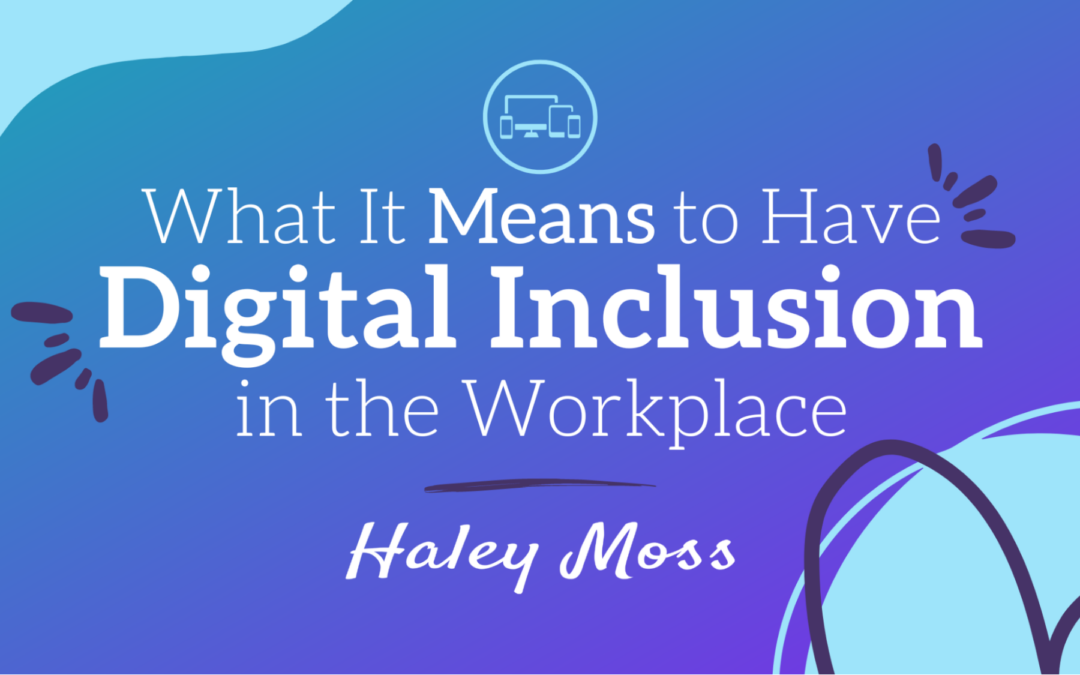Digital inclusion is for EVERYONE. In our day and age of working remotely or in a hybrid setting, the need for digital inclusion has become a necessity for everyone, not just those in the neurodiverse community. However, implementing digital inclusion in the hopes of creating a more open and inclusive workplace for neurodivergent individuals can help open up many job opportunities that might not otherwise be available. The term might not be well-known, so let’s dive into it and see how workplaces everywhere could benefit.
Firstly, What Is Digital Inclusion?
To implement digital inclusion, you first need to know what it is. Essentially, digital inclusion is when individuals have the ability to access, understand, and use technology in a meaningful and safe way. It is essential in our modern society as technology has taken a critical role in our daily lives and careers. It goes beyond simply giving access to technology; it includes education so people can use it in ways to better themselves personally and professionally. In a workplace, digital inclusion can look like understanding possible risks, innovating in new ways, and properly approaching processes and work regulations.
Why Digital Inclusion Is Important in the Workplace
Creating a strategy for digital inclusion in the workplace can help eliminate institutional and structural barriers to ensure that everyone is able to progress and succeed in the workplace, no matter the level of digital literacy they might walk in with. No matter the level of literacy someone might have, implementing digital inclusion can help boost security and processes in your business.
Digital inclusion can also open the doors to a more diverse workforce, giving you the opportunity to broaden your hiring process. It can offer a level of respect, safety, and openness that other businesses might not provide. Digital inclusion is a significant factor in implementing assistive technology for those with learning difficulties, visual impairments, hearing impairments, or other disabilities that might be a barrier when searching for jobs. This type of inclusion is not just to teach your current team about new safety measures, but it is a key way to attract and retain a diverse workforce.
Key Elements to Implement in Order to Have Successful Digital Inclusion
1. Awareness
In order to develop a strategy for digital inclusion, you need to be aware of the business’s areas of improvement. You must know where you can fix and grow certain workplace sectors. This can be done by assessing your hiring process, speaking with your current teams, or trying out some of the day-to-day tasks yourself.
2. The Proper Training Protocols
Digital skills are a necessity as we continue into a technological age. Digital literacy is not something we can avoid any longer, and to ensure you are preparing your current and future team for success, having digital literacy training is essential. Training for everyone can put everyone at the same level and ensure everyone has access to the help they need.
3. Inclusive Services
Everyone learns differently, and if you are reaching for a more diverse workforce, you must ensure your training protocols and inclusivity procedures are as inclusive as they should be. For example, there are many technology services available for those with disabilities. You can implement assistive technology, intuitive interfaces, and even multilingual support to ensure you are providing the best.
4. Advocacy
Working toward digital inclusion is a great first step toward advocacy for those with disabilities or who need more education on the technology around them. As a leader, you can help create a workplace that supports and advocates for everyone on your team, and implementing digital inclusivity can be the first step to achieving that.
Digital inclusion has become a non-negotiable in our technological society. Having this level of inclusion can be essential to ensure you are opening your business up to a diverse workforce. If you wish to learn more or have me speak on this topic at your workplace, contact me!

